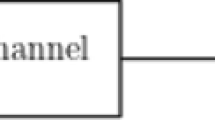Abstract
In this paper we analyze performance of practical robust data-hiding in channels with geometrical transformations. By applying information-theoretic argument we show that performance of a system designed based on both random coding and random binning principles is bounded by the same maximal achievable rate for the cases when communication channel includes geometrical transformations or not. Targeting to provide theoretic performance limits of practical robust data-hiding we model it using a multiple access channel (MAC) with side information (SI) available at one of encoders and present the bounds on achievable rates of reliable communications to such a protocol. Finally, considering template-based and redundant-based design of geometrically robust data-hiding systems, we perform security analysis of their performance and present results in terms of number of trial efforts the attacker needs to completely remove hidden information.
Similar content being viewed by others
References
O'Sullivan, J.A., Moulin, P., Ettinger, J.M.: Information-theoretic analysis of steganography. In: {Proc. IEEE Symp. on Information Theory}, Boston, MA (1998)
Moulin, P., O'Sullivan, J.A.: Information-theoretic analysis of information hiding. {IEEE Trans. Inf. Theory} 49(3), 563–593 (2003)
Somekh-Baruch, A., Merhav. N.: On the error exponent and capacity games of private watermarking systems. {EEE Trans. Inf. Theory} 49(3), 537–562 (2003)
Somekh-Baruch, A., Merhav. N.: On the capacity game of public watermarking systems. {EEE Trans. Inf. Theory} 20(3), 511–524 (2004)
Gallager, R.G.: A simple derivation of the coding theorem and some applications. {IEEE Trans. Inf. Theory} 11, 3–17 (1965)
Rhoads, G.B.: Steganography systems. International Patent WO 96/36163 PCT/US96/06618 (1996)
Pereira, S., Pun, T.: Fast robust template matching for affine resistant image watermarking. In: {International Workshop on Information Hiding}, volume LNCS 1768 of {Lecture Notes in Computer Science}, pp. 200–210, Dresden, Germany, 29 September–1 October (1999). Springer Verlag
Kutter, M., Petitcolas, F.A.P.: A fair benchmark for image watermarking systems. In: {IS&T/SPIE's 11th Annual Symposium, Electronic Imaging 1999: Security and Watermarking of Multimedia Content I}, vol. 3657, pp. 219–239, San Jose, CA, USA (1999)
Voloshynovskiy, S., Deguillaume, F., Pun, T.: Content adaptive watermarking based on a stochastic multiresolution image modeling. In: {10th European Signal Processing Conference EUSIPCO2000}, Tampere, Finland (2000)
Voloshynovskiy, S., Deguillaume, F., Pun, T.: Multibit digital watermarking robust against local nonlinear geometrical distortions. In: {IEEE Int. Conf. On Image Processing ICIP2001}, pp. 999–1002. Thessaloniki, Greece (2001)
Deguillaume, F., Voloshynovskiy, S., Pun, T.: Method for the estimation and recovering of general affine transforms in digital watermarking applications. In: {IS&T/SPIE's 14th Annual Symposium, Electronic Imaging 2002: Security and Watermarking of Multimedia Content IV}, vol. 4675, pp. 313–322, San-Jose, CA, USA, January 20–25 (2002)
Cover, T., Thomas, J.: {Elements of information theory}. Wiley and Sons, New York (1991)
Gel'fand, S.I., Pinsker, M.S.: Coding for channel with random parameters. {Probl. Control and Inf. Theory} 9(1), 19–31 (1980)
Petitcolas, F.A.P.: Stirmark benchmark 4.0. 2002. http://www.cl.cam.ac.uk/fapp2/watermarking/stirmark/
Gallager, R.G.: {Information theory and reliable communication}. Wiley, New York (1968).
Rimoldi, B.: Time-splitting multiple-access. Technical report, Mobile Communications Lab, EPFL, Switzerland (1999)
Haroutunian, M.E.: Bounds on e-capacity for multiple access channel with random parameters. {Transactions of Institute for Informatics and Automation Problems of NAS RA, Math. Prob. Comput. Sci.} 24 (2005)
Kerckhoff, A.: La cryptographie militaire. {J. Sci. Militaires} 9, 5–38 (1883)
Mihcak, M.K., Venkatesan, R., Kesal, M.: Cryptanalysis of discrete-sequence spread spectrum watermarks. In {Proceedings of the 5th International Information Hiding Workshop (IH 2002)}, Noordwijkerhout, The Netherlands (2002)
Shannon, C.E.: Communication theory of secrecy systems. {Bell Syst. Tech. J.} 28, 656–715 (1949)
Costa, M.: Writing on dirty paper. {IEEE Trans. Inf. Theory} 29(3), 439–441 (1983)
Proakis, J.G.: {Digital Communications}. McGraw-Hill (1995)
Author information
Authors and Affiliations
Corresponding author
Rights and permissions
About this article
Cite this article
Topak, E., Voloshynovskiy, S., Koval, O. et al. Towards geometrically robust data-hiding with structured codebooks. Multimedia Systems 11, 121–132 (2005). https://doi.org/10.1007/s00530-005-0196-1
Published:
Issue Date:
DOI: https://doi.org/10.1007/s00530-005-0196-1




